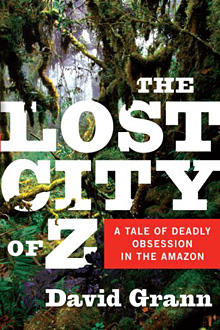
|  |  |  Entertainment | Books | March 2009 Entertainment | Books | March 2009  
An Explorer Drawn to, and Eventually Swallowed by, the Amazon
 Michiko Kakutani - New York Times Michiko Kakutani - New York Times
go to original


| The Lost City Of Z: A Tale of Deadly Obsession in the Amazon
by David Grann
Illustrated. 339 pages. Doubleday. $27.50. |  |
Imagine a swashbuckling British version of Indiana Jones with a mustache and maybe a pith helmet and a fondness for talking about his “Destiny,” and you get a pretty good picture of Col. Percy Harrison Fawcett.

In the early decades of the 20th century this former spy turned explorer extraordinaire made a series of daring expeditions into the heart of the darkest Amazon, where, as David Grann’s entertaining new book, “The Lost City of Z,” recounts, he faced hostile tribesmen armed with blow darts and poison arrows, and encountered crocodiles, jaguars, piranhas, vampire bats, giant anacondas and every pestilent insect imaginable, from cyanide-squirting millipedes to “sauba ants” that could reduce a man’s clothes “to threads in a single night” to “eye lickers” that invade the pupils.

As Mr. Grann, a writer for The New Yorker, explains in these pages, Fawcett was renowned in his day as the “David Livingstone of the Amazon” — “the last of the great Victorian explorers who ventured into uncharted realms with little more than a machete, a compass and an almost divine sense of purpose.”

“For nearly two decades,” Mr. Grann observes, stories of Fawcett’s adventures “captivated the public’s imagination: how he had survived in the South American wilderness without contact with the outside world” and “how he emerged with maps of regions from which no previous expedition had returned.”

But Fawcett and his two companions on a 1925 expedition, his 21-year-old son, Jack, and Jack’s best friend, Raleigh Rimell, never returned from that trip. In 1953, nearly three decades after his mysterious disappearance, The London Geographical Journal declared: “Fawcett marked the end of an age. One might almost call him the last of the individualist explorers. The day of the aeroplane, the radio, the organized and heavily financed modern expedition had not arrived. With him, it was the heroic story of a man against the forest.”

“The Lost City of Z” is at once a biography, a detective story and a wonderfully vivid piece of travel writing that combines Bruce Chatwinesque powers of observation with a Waugh-like sense of the absurd. Mr. Grann treats us to a harrowing reconstruction of Fawcett’s forays into the Amazonian jungle, as well as an evocative rendering of the vanished age of exploration, which witnessed feats like Livingstone’s finding of Victoria Falls, the Amundsen and Scott expeditions to the South Pole and Hiram Bingham’s discovery of the lost city of Machu Picchu.

To top it off, Mr. Grann gives us a suspenseful, often comical account of his own efforts as a complete tenderfoot (who confesses he doesn’t even like to camp and who outfits himself at an upscale Manhattan outdoors store that sells things like “adrenaline socks” and “Techwick ‘skivvies’ ”) to retrace Fawcett’s last known steps in the “green hell” of the Amazon, even though as many as 100 “Fawcett freaks” have died over the decades in similar quests.

The Amazon was regarded by many as a paradigm of Thomas Hobbes’s state of nature, where there are “no Arts; no Letters; no Society,” only “continuall feare, and danger of violent death,” and Fawcett himself viewed the legend of El Dorado (the conquistadors’ dream of a city of gold, which had already claimed so many lives) as an “exaggerated romance.”

Still, he remained convinced, in Mr. Grann’s words, “that an ancient, highly cultured people still existed in the Brazilian Amazon and that their civilization was so old and sophisticated it would forever alter the Western view of the Americas.” If this lost world — what Fawcett called the City of Z — really existed, Mr. Grann suggests, it could undermine the theory of environmental determinism, which argues that societies are captives of geography, that “even if some early humans eked out an existence in the harshest conditions on the planet, they rarely advanced beyond a few primitive tribes.”

While situating Fawcett’s adventures in cultural and historical contexts, Mr. Grann provides a rollicking reanimation of Fawcett’s remarkable life, which took him from military service in Ceylon to school at the Royal Geographic Society in London (where he learned the fundamentals of scientific observation and how to cook insects and make pillows out of mud) to the wilds of South America.

He ends his narrative with a fascinating visit with the archaeologist Michael Heckenberger, who has been excavating what Mr. Grann describes as “a vast ancient settlement” in the very region where Fawcett is believed to have vanished. The settlement, Mr. Heckenberger says, included three moats; a giant, circular plaza; a sprawling neighborhood of dwellings; and some sort of roads and ramps — a vision out of Escher and Borges, closely approximating, some might argue, Fawcett’s City of Z.

Fawcett’s adventures are said to have helped inspire Arthur Conan Doyle’s 1912 novel, “The Lost World,” in which explorers “disappear into the unknown” of South America and find a land where dinosaurs have escaped extinction, as well as “Indiana Jones and the Seven Veils,” one of the novels spun off from the popular “Raiders of the Lost Ark” movie.

As for Mr. Grann’s book, it reads with all the pace and excitement of a movie thriller and all the verisimilitude and detail of firsthand reportage, and it seems almost surely destined for a secure perch on the best-seller lists. |

 |
|  |



